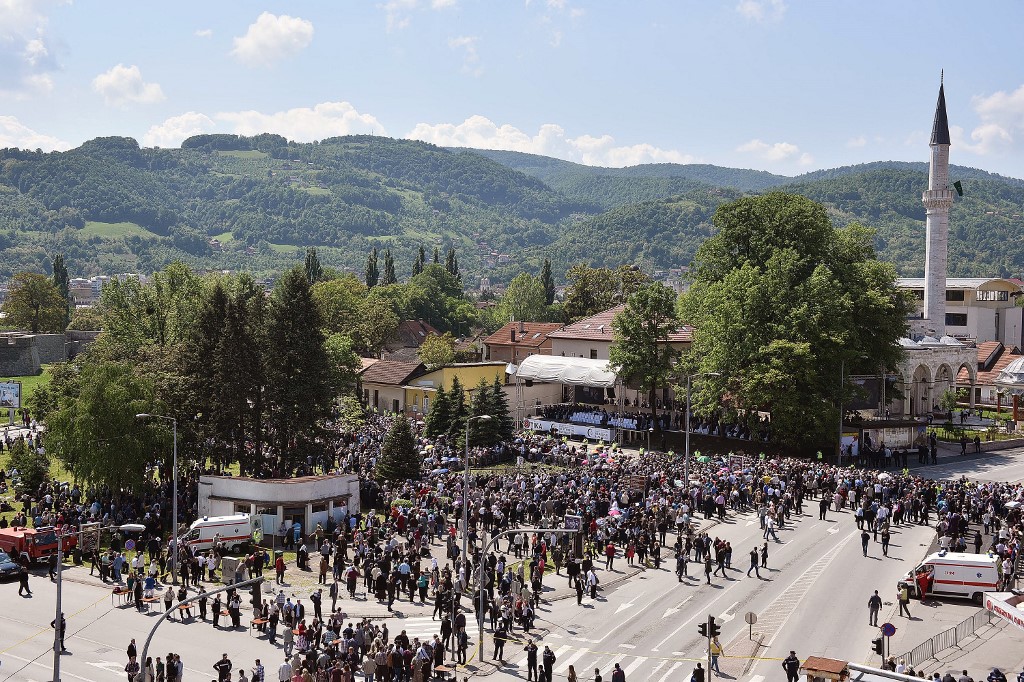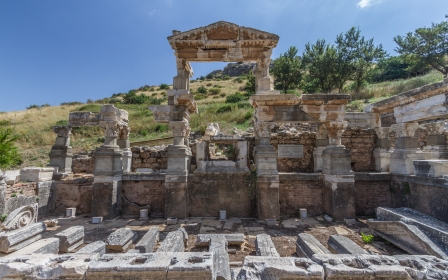Scars of war: The historic structures that fell during the Bosnian conflict
Bosnia is currently going through its worst political crisis since the end of the Yugoslav Wars in the 90s, after Bosnian Serbs blocked decision-making in national institutions and launched a process to withdraw from the state armed forces, tax system and judiciary.
The conflicts of the 90s had a strong ethnic and religious aspect, with Bosnian Muslims pitted against Bosnian Serbs and Croats, forming alliances with the latter at a number of points during the war.
The 1995 Srebrenica massacre, in which 8,000 Bosnian Muslim men and boys were killed by Bosnian Serb forces led by General Ratko Mladic, remains a source of deep suffering, with survivors having told Middle East Eye in 2020 that they are having to endure a growing local culture of genocide denial.
Today, Bosnia-Herzegovina is a state with two constituent parts: a Bosnian Serb entity known as Republika Srpska, and the Federation of Bosnia and Herzegovina, in which Bosnian Muslims form a majority.
And while the aftershocks of the war can still be felt in the region’s struggle for a peaceful future, the scars of the conflict are there on many of the buildings and historic sites around Bosnia.
Here, Middle East Eye looks at some of the famous landmarks and mosques that were heavily damaged or destroyed – by a number of different forces – during the war.
In them we see the long history of a region at the crossroads of the world, one that has known great devastation.
1. Ferhadija Mosque, Banja Luka city
Showcasing ornate Islamic architecture popular in the 16th century, the Ferhadija mosque in the city of Banja Luka is sometimes referred to as the Ferhat Pasha mosque.
The mosque was considered a significant architectural achievement and was built in 1579 on the orders of Ferhad Pasha Sokolovic, an Ottoman general and statesman from Bosnia.
While the exact architect involved is not known, based on the designs, it is likely that they were a student of the famed 16th century Ottoman architect Mimar Sinan (Sinan the Architect).
Some of the stand-out details of the mosque included it’s intricate Ottoman architecture, a courtyard and a fountain. The fountain had a stone basin, and twelve pipes.
The mosque was largely destroyed by Serb militias in May 1993, with its minaret surviving the first explosion, only to crumble in subsequent attacks.
In 2001, a building permit was granted to the city’s Islamic Community of Banja, causing controversy among Serb nationalist groups, with some attacking those attending the initiation ceremony with rocks.
Despite attempts to prevent the rebuilding of a new mosque on the site where the Ferhadija once stood, the opening went ahead in May 2017 amid heavy police presence, and was attended by Bosnian leaders as well as international dignitaries.
2. Old Bridge, Mostar
The mountainous city of Mostar is known for its beauty, history and architectural heritage, much of it inspired by Mimar Sinan.
Sometimes referred to as the Stari Most, the Old Bridge was commissioned by Suleiman the Magnificent in 1557 and designed by Sinan's student, Mimar Hayruddin.
However, the 17th century Ottoman traveller Evliya Celebi attributes the building of the structure to Sinan himself.
Celebi describes boys jumping off the bridge, "flying like birds", into the river Neretva below, a tradition that continues to this day.
"God keeps them unharmed and they immediately clamber on to the shore," he writes.
During Ottoman rule (1482-1878), the city was considered a strategic location and the bridge, which took nine years to complete, was key in connecting the two parts of the city.
The bridge stood for four centuries, until it was turned to rubble in November 1993 by Croat forces shelling at the height of the war, causing it to collapse into the Neretva.
The bridge was reconstructed in 2004, in an effort funded by several nations, including Italy, the Netherlands, Turkey and Croatia, as well as the Council of Europe Development Bank.
In 2005, the bridge was added to Unesco’s World Heritage List, commended for its symbolic value and for representing healing and reconciliation.
Every summer, divers flock to the bridge to take part in an annual competition.
3. Gazi Hursev Beg, Sarajevo
The 16th century mosque of Gazi Husrev Beg was designed by Adzem Esir Ali, the chief architect of Istanbul.
One of the largest mosques in the country, it was also notable for its intricate Ottoman architectural designs.
The mosque was named after the Ottoman Bosnian governor Gazi Husrev, who is credited with helping the Ottoman empire secure its hold on Croatia and Hungary.
In 1898 during Austro-Hungarian rule, the mosque earned the distinction of becoming the first in the world to be powered by electricity.
The building was famed for its iconic dome, which featured elaborate stalactite designs, and also its windows, which gave the illusion of being much larger than they actually were.
During the siege of Sarajevo (1992-1996), the mosque was heavily damaged but later rebuilt with donations from other countries. Bosnian calligrapher Hazim Numanagic helped to redesign the interior in 2001.
Today, the house of worship serves as one of the most important buildings in the Bosnian capital.
4. Vijecnica, Sarajevo
In August 1992, Serb forces positioned on the mountains surrounding Sarajevo targeted the National and University Library (NUL), engulfing it in flames.
The building that housed the library, named Vijecnica, features Islamic-style arches and is notable in that it was an example of European architects incorporating Islamic styles.
Built by Czech architect Karel Parik at the end of the 19th century for use as Sarajevo's city hall, the building was visited by Archduke Franz Ferdinand and his wife Sophie shortly before their assasination by a Serb nationalist in 1914, sparking the First World War.
The building was later turned into a library in 1949.
The institute held over 1.5 million volumes and more than 155,000 rare books, archives and manuscripts. Many of the manuscripts touched on the histories of the Ottoman and Austro-Hungarian empires.
The attack on the library resulted in 80 percent of its contents being fully destroyed, including original documents dating back to the Ottoman empire.
The building re-opened in May 2014, with over half the cost of restoration being paid for by the European Union.
Unesco also assisted in the restoration of the structure, allowing it to once again stand as a symbol of Bosnia's history.
The library is now a go-to spot for tourists, and houses the city council and a museum.
5. Oriental Institute, Sarajevo
Founded in 1950, the academic institute was part of the University of Sarajevo, and was known for its programmes on the Arabic, Turkish and Persian languages and literature.
The Oriental Institute was important in the research and preservation of Bosnia’s Ottoman history and behind its doors were over 5,000 manuscripts, covering topics as diverse as theology, astrology and philosophy.
On 17 May 1992 the JNA/VRS intentionally destroyed the Oriental Institute in Sarajevo eliminating thousands of documents related to the history of Bosniaks and Bosnia and Herzegovina. pic.twitter.com/yA2XkTOnCh
— Hikmet Karcic (@hikmet_karcic) May 17, 2019
During the siege of Sarajevo in 1992, it was burnt down using incendiary shells, causing thousands of archived documents to be lost.
The institute was later rebuilt with funding from Turkey and is once again open to researchers and students, where it hosts two large reading rooms.
This article is available in French on Middle East Eye French edition.
Middle East Eye propose une couverture et une analyse indépendantes et incomparables du Moyen-Orient, de l’Afrique du Nord et d’autres régions du monde. Pour en savoir plus sur la reprise de ce contenu et les frais qui s’appliquent, veuillez remplir ce formulaire [en anglais]. Pour en savoir plus sur MEE, cliquez ici [en anglais].







